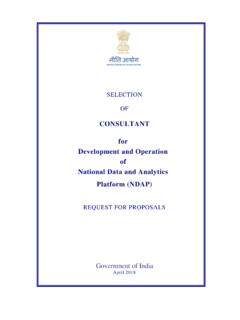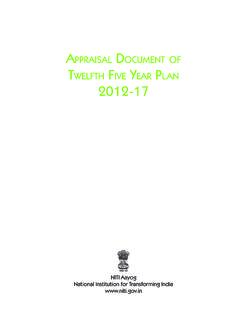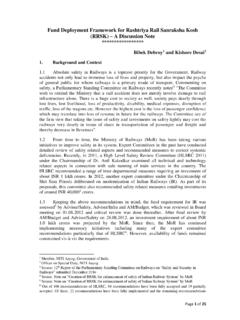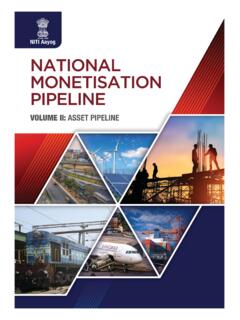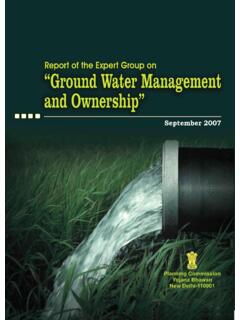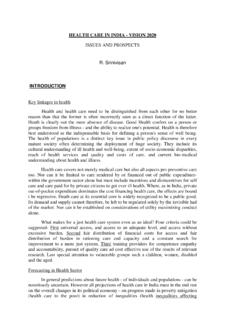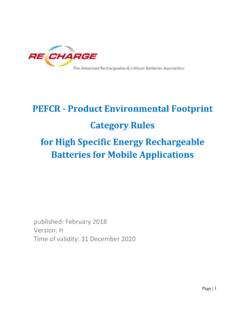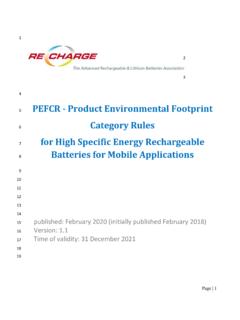Transcription of Roadmap for India: 2019-2032 - NITI Aayog
1 AEnergy Storage System Roadmap for India: 2019-2032 Energy Storage System Roadmap for India: 2019-2032 Supporting AgencyKnowledge PartnerEnergy Storage System Roadmap for India: 2019-2032iiiEnergy Storage System Roadmap for India: 2019-2032vEnergy Storage System Roadmap for India: 2019-2032 PrefaceAt COP 21 in Paris in 2015, India made a commitment of meeting 33-35% of its energy from non-fossil fuels by 2030. This bold commitment requires a host of new policy initiatives to scale up the share of clean energy drastically. The 175 GW of renewable energy target by 2022 needs to be enhanced to 500 GW or more through new policies and programs in the following 8 years running to 2030.
2 The integration of distributed generation resources on the low voltage grid require the support of active demand response and energy storage systems to maintain grid stability. In a fast-changing technological environment, it is important to have a clear vision of priorities and needed actions to realize the full benefits of energy storage to help in accelerating the deployment of renewable energy technologies. In February 2018 , an Expert Committee under the chairpersonship of Secretary, Ministry of New and Renewable Energy, with representatives from relevant Ministries, industry associations, research institutions and experts were constituted by the Ministry of New & Renewable Energy to plan the launch of a National Energy Storage Mission for India.
3 This initiative was subsequently moved to NITI Aayog and Government of India launched the Transformative Mobility and Energy Storage Mission in March order to support the energy storage mission of the Government of India, ISGF initiated preparation of an Energy Storage Roadmap for India 2019 2032 in association with India Energy Storage Alliance (IESA). The initial objective of the Roadmap was to study in detail the grid integration issues related to 40 GW of solar rooftop that will be connected to medium and low voltage grid (MV and LV grid).
4 We have undertaken detailed modelling studies of MV and LV grids in six states in India using CYMDIST software. The evaluation of the effectiveness of energy storage technologies in addressing the grid stability issues with high levels of VRE penetration detailed in the report will help the policy makers, regulators and utilities in planning for rooftop PV rollouts. The key outcomes of this study are: 1. Energy Storage Roadmap for India 2019-2032 ; 2. Energy Storage India Tool (ESIT) and; 3.
5 Guidelines for determining the Variable Renewable Energy ( VRE) hosting capacity on LV and MV grids. The ESIT tool developed as part of the project for techno-commercial evaluation of ESS projects will help the stakeholders choose the optimum levels of ESS for different applications. The guidelines for assessing the hosting capacity of VRE on the distribution grid will help utilities to plan their grid upgrade requirements to match with the expected penetration of Kumar PillaiPresident, India Smart Grid ForumChairman, Global Smart Grid FederationviEnergy Storage System Roadmap for India.
6 2019-2032We started the project to estimate the energy storage systems (ESS) requirements for 40 GW rooftop PV integration, but the scope was enlarged to include total ESS requirements in the country till 2032. This was done keeping in view of the fact that the ESS requirements for electric mobility is much larger than that for grid applications. Although we closely examined the viability of different ESS technologies, we have finally chosen to estimate the ESS requirements in terms of lithium Ion Batteries owing to its versatile applications and fast declining cost.
7 This is a first of its kind work and the estimates given in this report may be debatable due to policy uncertainties. However, we hope this energy storage Roadmap will instil confidence in the industry and investors for building manufacturing capacities in the country on fast track. India Smart Grid Forum (ISGF) would like to take this opportunity to thank MacArthur Foundation for supporting this study and we wish to dedicate our strong commitment to work towards making a greener and cleaner future. I would also like to thank all the stakeholders for their valuable contribution in preparation of this Roadmap for India, particularly, Shri Gupta, Additional Secretary, NITI Aayog and his team, Dr.
8 Maithani, Scientist-G, MNRE and Mr. Vivek Goel, Chief Engineer - Distribution Planning & Technology, CEA, who have provided valuable inputs for this Storage System Roadmap for India: 2019-2032 Authors & AcknowledgementIndia Smart Grid Forum (ISGF) would like to express our sincere gratitude to MacArthur Foundation who has extended a grant to ISGF for undertaking first of its kind project in the country to prepare an Energy Storage Roadmap for India 2019 2032. MacArthur Foundation works to primarily support mitigation interventions that seek sustainable solutions to challenges India faces from climate would like to thank Mr R P Gupta, Additional Secretary, NITI Aayog and his team for providing all the necessary guidance and support to undertake the study for the preparation of this wish to thank Mr Mrityunjay Kumar Narayan, Joint Secretary, and Mr Vishal Kapoor, Director, Ministry of Power.
9 For their support for this important would like to thank Dr P C Maithani, Scientist-G, Ministry of New and Renewable Energy (MNRE) and his team for extending their support and guidance throughout this study. We would like to thank Mr Vivek Goel, Chief Engineer Distribution Planning and Technology, Central Electricity Authority (CEA) and his team for providing all the necessary guidance related to the electrical infrastructure of the would like to thank all the six distribution companies, Adani Energy Mumbai Ltd (AEML), Andhra Pradesh Southern Power Distribution Company Ltd (APSPDCL), Bangalore Electricity Supply Company Ltd (BESCOM), CESC Ltd (Kolkata)
10 , Tata Power Delhi Distribution Ltd (TPDDL) and Uttar Haryana Bijli Vitran Nigam (UHBVN), who helped us in conducting the load flow studies of their distribution also wish to extend our sincere gratitude to all the stakeholders whom we consulted during the course of this study for their cooperation and relevant inputs which were very valuable for this Storage System Roadmap for India: 2019-2032 Authors and ContributorsIndia Smart Grid Forum India Energy Storage AllianceAkshay Srivastava Avanthika Satheesh Balasubramanyam Karnam Epica Mandal Sarkar Bindeshwary Rai Harsh Thacker Harpreet Singh Pranao Walekar Ravi
